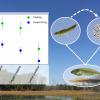Description
- Predators and pathogens are fundamental components of ecological communities that have the potential to influence each other via their interactions with victims and to initiate density- and trait-mediated effects, including trophic cascades. Despite this, experimental tests of the healthy herds hypothesis, wherein predators influence pathogen transmission, are rare. Moreover, no studies have separated effects mediated by density vs. traits. Using a semi-natural mesocosm experiment, we investigated the interactive effects of predatory dragonfly larvae (caged or lethal [free-ranging]) and a viral pathogen, ranavirus, on larval amphibians (gray treefrogs and northern leopard frogs).
- We determined the influence of predators on ranavirus transmission and the relative importance of density- and trait-mediated effects on observed patterns. Lethal predators reduced ranavirus infection prevalence by 57–83% compared to no-predator and caged-predator treatments. The healthy-herds effect was more strongly associated with reductions in tadpole density than behavioral responses to predators.
- We also assessed whether ranavirus altered the responses of tadpoles to predators. In the absence of virus, tadpoles reduced activity levels and developed deeper tails in the presence of predators. However, there was no evidence that virus presence or infection altered responses to predators.
- Finally, we compared the magnitude of trophic cascades initiated by individual and combined natural enemies. Lethal predators initiated a trophic cascade by reducing tadpole density, but caged predators and ranavirus did not. The absence of a virus-induced trophic cascades is ostensibly the consequence of limited virus-induced mortality and the ability of infected individuals to continue interacting with the community.
- Our results provide support for the healthy herds hypothesis in amphibian communities. We uniquely demonstrate that density-mediated effects of predators outweigh trait-mediated effects in driving this pattern. Moreover, this study was one of the first to directly compare trophic cascades caused by predators and pathogens. Our results underscore the importance of examining the interactions between predators and pathogens in ecology.
Cite this work
Researchers should cite this work as follows:
- Hoverman, J. T.; Gallagher, S. (2019). Healthy but smaller herds: Predators reduce pathogen transmission in an amphibian assemblage. Purdue University Research Repository. doi:10.4231/BVZE-3057
